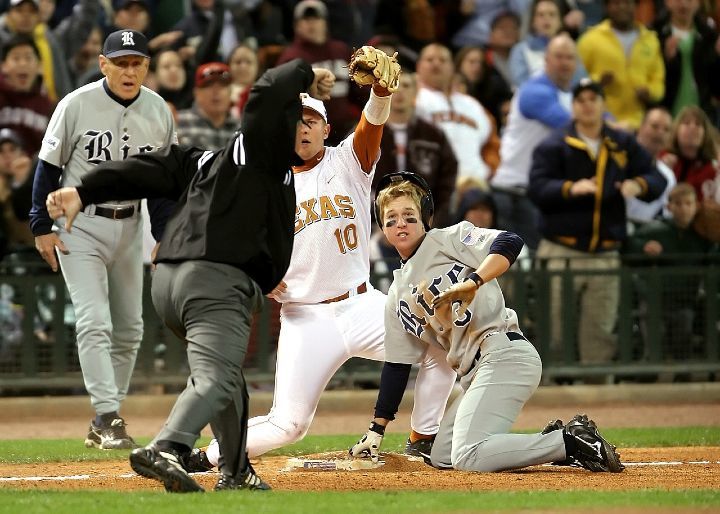Baseball has a few rather complicated rules, and the balk is definitely one of them.
It is one of the most misunderstood rules in the game, and while it doesn't seem to happen too often, it does occur from time to time.
But why is it such a difficult rule to understand?
One of the main reasons is there are 13 different ways that a balk can be committed!
Before we dive headfirst into all thirteen of them, though, it's important to understand what a balk actually is -- generally speaking -- as well as the history of the infraction, and why it's in place today.
The History - What is a Balk?
A balk is an infraction that can be committed by only a pitcher -- and only when there is at least one runner on base.
The rule was created to prevent pitchers from being able to deceive baserunners on opposing teams.
While the pitcher can try to keep baserunners off balance by nodding his head, stepping off the mound, throwing a pick-off attempt, and/or taking his time to throw a pitch…
He CANNOT make any motions that are meant to outright deceive the runners.
There was a time in baseball when a pitcher was allowed to fake a throw to any base, but that is not allowed anymore.
In fact, as of the 2013 season, Major League Baseball outlawed a common move by pitchers that would entail them faking a throw to third base and then throwing the ball to first base when runners were on those bases.
Now, this is considered a balk.
What Happens When a Balk is Called?
When a balk is called, the play is called dead by the umpire, and all runners on base are awarded the next base.
That means if there are runners on first and second, for example, they would move to second and third base, respectively.
If the umpire isn't able to call the play dead before the pitcher delivers the pitch, the play can continue on.
If the outcome of the play is the batter reaches at least first base and all runners advance at least one base, then the balk is null and void.
If not, then the balk will be called into effect after the pitch is thrown.

The 13 Different Balks in Baseball
Now that you know what a balk is, here are the 13 different ways that a pitcher can commit a balk, according to the official MLB rules:
1.
If a pitcher fakes a throw to first base while touching the rubber but doesn't actually make the throw. The pitcher can fake a throw to either second base or third base as long as there aren't any runners on those bases. And a pitcher can also fake a throw to first base if he steps back of the rubber first.
2.
If the pitcher fails to deliver a pitch to home after making a natural pitching motion.
3.
If the pitcher makes a pitch that is illegal, such as a quick pitch where he pitches from off the rubber.
4.
If the pitcher doesn't step directly toward the base before he throws to that base. This means a pitcher can't throw then make a step. Umpires will often require pitchers to step within a 45-degree angle of first base when making a pickoff attempt, for example.
5.
If the pitcher either fakes or actually throws to a base that is not occupied, except when he's making a play. If a runner breaks for second, for example, the pitcher is allowed to throw to second even though there is technically not a runner occupying that base.
6.
If the pitcher makes a motion that would naturally be associated with delivering a pitch when they are not touching the rubber.
7.
If the pitcher delivers the ball to the batter when they are not facing that batter.
8.
If the pitcher delays the game unnecessarily.
9.
If the pitcher removes one hand from the ball after coming to a set pitching position. Of course, this doesn't apply when he is releasing the ball.

10.
If the pitcher delivers a pitch without coming to a complete stop to the set position. Changing his direction is not coming to a complete stop.
11.
If the pitcher conducts a fake when he doesn't have the ball. This applies whether the pitcher is on the rubber or not.
12.
If the pitcher drops the ball when he is on the rubber. It doesn't matter whether he does this accidentally or on purpose.
13.
If the pitcher delivers an intentional walk while the catcher isn't in the catcher's box. The catcher must start in the catcher's box and then move outside after the ball leaves the pitcher's hand. Because this is reliant on what the catcher does, it is often called a "catcher's balk." In MLB today, teams can avoid actually throwing the ball during an intentional walk -- making this rule moot -- but not all levels of baseball have adopted that yet.
Conclusion
A balk is one of the more difficult rules to understand in baseball, specifically because there are so many different ways in which a pitcher can commit the infraction.
If you're a pitcher trying to learn what not to do, the easiest way to understand the rule is to know that you can't deceive the runner in any way.
If you keep to that mindset, it'll be a lot easier for you to navigate the game, rather than trying to learn all 13 ways that you can commit a balk.

